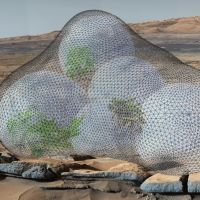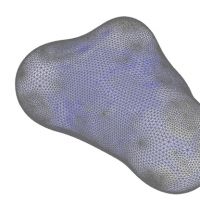Tag: sphere-packing
-
 Form finding of deep exploration surface habitatsValentina Sumini and Caitlin Mueller, Proceedings of the International Association for Shell and Spatial Structures (IASS), 2017
Form finding of deep exploration surface habitatsValentina Sumini and Caitlin Mueller, Proceedings of the International Association for Shell and Spatial Structures (IASS), 2017A renewed interest in space exploration, mainly proved by the recent funding that NASA received for sending human to Mars by 2030, led to new challenges in architecture and structural engineering. Space architecture is deeply interdisciplinary and connects different fields of research such as aerospace engineering, architecture, design, space science, medicine, psychology and art.
This research aims to explore form finding strategies for deep space exploration habitats on extraplanetary surfaces such as the Moon and Mars. In this paper, a new sphere packing form finding approach has been studied, trying to optimize the location of different system and subsystems inside a space habitat and respond to the high pressure differentials required in these environments.
The potential impact of this study relates to the possibility of designing in real-time the final layout of the habitat by simply defining the linkages between functions and subsystems. This method could be applied to different scales of the habitat, from the urban level down to the architectural one, and to even more complex systems.
Moreover, being the obtained functional diagram readily translated in a structural Finite Element model, it was possible to prove that the reduced gravity is a negligible load when designing for space habitats that, have a differential pressure of about 100 kPa. Therefore the internal pressurization is the main load to consider. Future research could expand this study analyzing also other types of loads, such as the micrometeoroid impact, and the airlock systems.
-
 Space Architecture: form finding strategies and multiobjective optimizationResearch, 2016 - 2017
Space Architecture: form finding strategies and multiobjective optimizationResearch, 2016 - 2017This research aims to explore form finding strategies for deep space exploration habitats on extraplanetary surfaces such as the Moon and Mars. A new sphere packing form finding approach has been studied, trying to optimize the location of different system and subsystems inside a space habitat and respond to the high pressure differentials required in these environments. Typically the organization of the interior layout follows the functional needs of the crew, such as working, hygiene, preparing and eating food, etc. To respond to relationships between such functional areas, including sizing, adjacencies, and approximate shapes, architects traditionally have used bubble diagrams and adjacency matrices as design aids. This research combines and digitizes these approaches with a sphere packing algorithm powered by dynamic relaxation, which allocates all required activities and respects all analyzed linkages between functions and subsystems. Furthermore, the obtained functional diagram is readily translated in architecture through a transformation into a tension-only pressurized surface using form-finding tools. The resulting habitat design is evaluated, in terms of its structural performance, through FE analysis tools. In summary, this research presents a new computational design method for space surface habitats that responds to both functional and physical requirements, offering new ways to support future space exploration.


